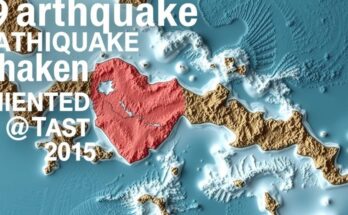Hezbollah confirmed the death of its leader Hassan Nasrallah, killed by an Israeli airstrike in Beirut. The airstrike, part of Israel’s ongoing campaign against Hezbollah, resulted in several casualties and significant destruction. Israeli officials indicated further military actions were planned, amidst rising tensions in the region. This incident signifies a critical escalation in the long-standing conflict between Israel and Hezbollah, with widespread implications for regional stability.
The Lebanese militant group Hezbollah confirmed on Saturday that its leader, Hassan Nasrallah, was killed in an Israeli airstrike in Beirut the previous day. Nasrallah had been a significant figure in Hezbollah’s leadership for over three decades. Following his death, Hezbollah declared its intentions to continue its struggle against what it termed “the enemy” and to support the Palestinian cause. The Israeli military reported that it conducted a targeted airstrike on Friday while Hezbollah leaders were convening at their headquarters in the Dahiyeh district of Beirut. The attack resulted in the deaths of several individuals, including prominent Hezbollah commanders, and left numerous others injured, while also causing substantial destruction to surrounding buildings. The airstrike’s aftermath has sparked further tensions in the region; the Lebanese Health Ministry confirmed six fatalities and 91 injuries attributed to the attack, which also resulted in the destruction of multiple apartment structures. Notably, the strike also claimed the life of Abbas Nilforushan, a general in Iran’s paramilitary Revolutionary Guard. The ramifications of Nasrallah’s assassination represent a significant escalation in the ongoing conflict between Israel and Hezbollah, particularly as hostilities have intensified over the past week. In response to the attack, Israeli officials, including Chief of Staff Lt. Gen. Herzi Halevi, suggested that the elimination of Nasrallah would not be the final action taken against Hezbollah, indicating that further military operations were anticipated. Meanwhile, air raid sirens were triggered across central Israel, marking a heightened state of alert following missile interceptions from Yemen targeting Israeli territory. The situation remains precarious, with both sides experiencing heavy casualties amidst what has escalated into a year-long exchange of hostilities, following an initial major assault by Hamas militants from Gaza. As Israel solidifies its military response, questions loom over the potential shifts in Hezbollah’s command structure and Iran’s forthcoming reactions to these developments.
The recent escalation in the Middle East stems from a series of hostilities that began on October 8, following a significant attack by Hamas against Israel. This prompted retaliatory actions from both Israel and Hezbollah, leading to a sustained conflict characterized by cross-border missile strikes and heavy military engagements. Hezbollah has been actively supporting Gaza, which has intensified the conflict and affected civilian populations on both sides of the Israeli-Lebanese border. The recent assassination of Hassan Nasrallah not only removes a pivotal figure in the group but also raises concerns about potential shifts in military strategies within Hezbollah and the broader regional implications of continued Israeli airstrikes.
The assassination of Hassan Nasrallah marks a pivotal moment in the ongoing conflict between Israel and Hezbollah, with the potential to alter the power dynamics within the region dramatically. As both sides brace for continued military engagements, the humanitarian situation remains dire, with significant casualties reported on both sides. This incident has significant implications for the future of Hezbollah’s operations, Israeli military strategy, and regional stability, particularly given Iran’s role in supporting Hezbollah. The next actions taken by both Hezbollah and Israeli forces will be crucial in determining the trajectory of this conflict.
Original Source: www.pbs.org




